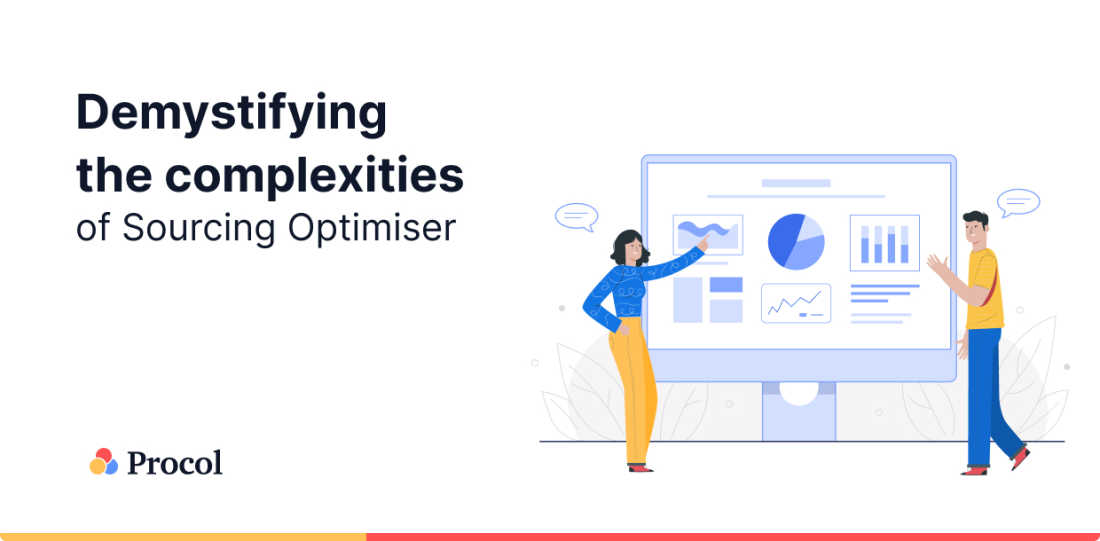Demystifying the complexities of Sourcing Optimiser

Is your business still managing sourcing using spreadsheets? Finding the right supplier that provides maximum cost savings is impossible with outdated methods. Simple spreadsheets are only useful when you compare a handful of suppliers and make important sourcing decisions. With a sourcing optimiser, you can automate the analysis process to choose a supplier that delivers cost savings with reduced risks. Sourcing optimisation is crucial for the digital transformation of the procurement process.
Why Are Conventional Sourcing Strategies Not Useful?
Organisations constantly work on improving sourcing outcomes. Many organisations are under pressure to reduce sourcing costs. They also have urgent product demands but must find optimal suppliers even for dynamic demands. Procurement technology has been around for some time, but organisations fall short when adopting digital tools. Organisations must optimise their sourcing strategy to advance their digital procurement journey.
Organisations have realised that large-scale sourcing is the answer to improving savings by encouraging supplier competition. Traditional sourcing strategies don’t have the flexibility to compare hundreds of suppliers at the same time. When enterprises choose large-scale sourcing, they often get more than 250 bids across several thousand lanes. Organisations must model and analyse thousands of bids with what-if questions to get the best-fitting supplier out of this massive pool.
Following are some of the challenges that conventional sourcing can’t address:
- Sorting through a huge repository of supplier data collected from a large supplier network.
- Large-scale sourcing results in dynamic sourcing conditions that are too complex for traditional spreadsheets and e-sourcing tools.
- Transportation costs continue to increase, and choosing a supplier with optimised transportation costs is crucial.
- Suppliers must be compared based on cost and non-cost parameters, further intensifying the complexity.
- Traditional sourcing involves a lot of manual work resulting in time delays.
- Redundancy and unstructured data silos result in inconsistent supplier data, causing non-compliance risks.
- Ineffective communication with external stakeholders makes it difficult for suppliers to offer competitive bids.
To incorporate digitalisation, many organisations moved towards e-sourcing, which involved using eRFX for procurement. While this eliminated manual offline work, it still doesn’t support optimisation. Partial automation on the procurement platform, including e-auctions, helps greatly in strategic sourcing. However, if your organisation wants to enjoy the benefits of sourcing optimisation for large-scale sourcing, you need a dedicated e-procurement application with a sourcing optimiser.
Procurement Solution with Sourcing Optimiser Breaks Down Large-Scale Sourcing Complexity
E-procurement along with sourcing optimiser results in what-if analysis models with advanced cognitive computing abilities to reduce the risk factors of large-scale sourcing. Adopting a sourcing optimiser instead of excel sheet-based e-sourcing will help your organisation to cut down the sourcing lifecycle by 50%. A Mckinsey study shows a 99% correlation between investing in digital procurement and organisational performance. Procurement optimisation will continue to benefit your organisation in the long term. A sourcing optimiser will help your business to enable, capture and sustain value in the sourcing process.

Source: McKinsey
A sourcing optimiser is a dedicated tool that automates the sourcing process through complex what-if analysis questions. Conditional automation is possible with the use of AI and machine learning algorithms. These algorithms can quickly evaluate supplier bids based on specified rules and conditions. Prescriptive sourcing bots will take over supplier comparison and present you with optimal suppliers. It makes it easier to incorporate cost and non-cost parameters when choosing a supplier. Once the machine learning model is set up, the self-learning autonomous bots will take over the sourcing process, allowing your sourcing team to focus on innovation.
While creating self-autonomous bots is the ultimate goal of sourcing optimiser tools, we are not there yet. You can implement sourcing optimisation using dedicated optimisation tools in the procurement platform to get all the benefits of large-scale sourcing while still maintaining manual evaluation. These tools score better than human decisions mainly because of the detailed analytics based only on supplier performance. No bias is involved, and rules can be set up exclusively to avoid supplier monopoly.
What to Expect From a Procurement Solution Embedded with Sourcing Optimiser?
The e-procurement application will help you implement large-scale sourcing in a few simple steps. This tool is created exclusively for procurement, thus optimising every procurement process. A procurement workflow can be created based on organisation goals. The dynamic application and interface allow you to make changes in real-time based on urgent business needs.
Sourcing optimisation is performed in the following stages:
1. Drafting Automation To create a sourcing event, relevant product data, including requirements, specifications, base prices, etc., are drafted automatically. Since the data is collected from multiple databases, it provides a consolidated overview of the various sourcing scenarios.
2. Simplified Bidding After creating the sourcing event, your organisation can immediately send notifications to onboarded suppliers to present their bids. Suppliers can directly get all the necessary product requirement data from the procurement system to make competitive bids. With real-time live collaboration, the platform encourages interactions between suppliers and buyers.
3. Robust Bid Analysis The source optimiser shows its true potential in the bid analysis stage. Even thousands of bids can be compared against each other in record time based on the rules specified. For example, your organisation can predefine procurement goals and specify what-if analysis for specific large-scale procurement. You can qualify suppliers based on parameters such as bundled discounts, supply quantity, delivery timelines, fulfilment percentage, and more.
4. Choose Optimal Suppliers Based on the advanced analytics, your organisation can choose suppliers that minimise risks, maximise cost savings, and ensure compliance.
Procol is the highest-rated procurement software that can revolutionise procurements for your organisation. Schedule a demo with us to learn how to implement a sourcing optimiser to compare and select the best supplier for your enterprise.
Get a Free Demo
We'd love to hear from you. Please fill out this form to schedule a demo with us. You can also give a call on +91 76666 82222



